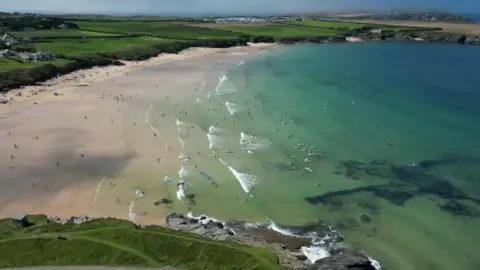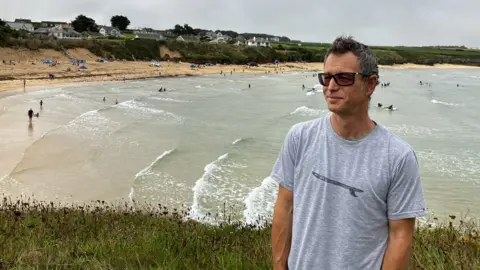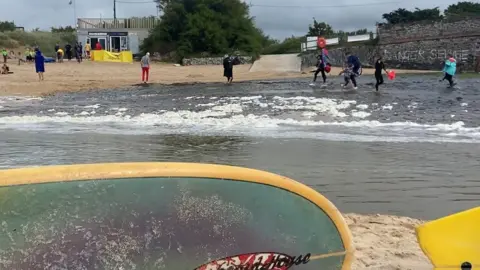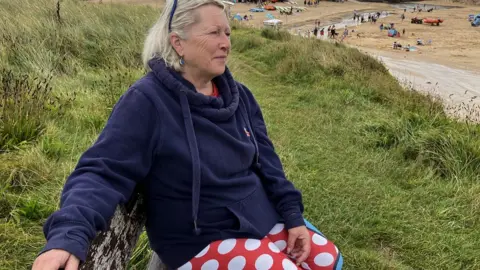Shock after sewage releases at Cornish tourist spot Harlyn Bay
 BBC
BBCWhen surfer William Howells returned to the sea a year after suffering a heart attack, the swell was not the main thing on his mind. It was the smell.
He said a wave of sewage releases in July left Harlyn Bay, Cornwall, "just smelling of excrement".
The former teacher said after being in the water he fell ill with vomiting and diarrhoea on 27 July - six days before a pollution warning was issued.
"For 18 hours straight I had my head down a toilet bowl," he said.
"The pain was incredible - I've never felt anything like it in my life."

South West Water (SWW) confirmed there were a number of permitted discharges in the area after heavy rainfall.
The firm said a record amount was being spent on reducing the use of storm overflows but relief valves were necessary to stop the system from being overwhelmed.
The valves release a mixture of raw sewage from homes and businesses, and rainwater run-off.
According to the Safer Seas and Rivers Service, run by the charity Surfers Against Sewage (SAS) using SWW data, there have been 13 discharges at Harlyn between 18 June and 18 August - one nearly every five days. Eight discharges occurred in July alone, during unseasonable rainfall.
 William Howells
William HowellsSWW confirmed the charity's data was correct.
The Environment Agency (EA) said it issued the pollution warning on 2 August and it was lifted the next day "after an investigation by officers and SWW".
However, there is mounting anger among some in the village over the level of information available to swimmers when a discharge occurs.
The bay, a tourist hotspot surrounded by farmland, campsites and some new development, has two SWW facilities nearby.
The first is a pumping station overflow, which releases into a stream at the back of the beach, and the second is a storm overflow on the headland.
 William Howells
William Howells'Culture of denial'
Mr Howells - who took videos of murky water and an overflowing drain on the headland - said the location of the pipes meant sewage "hit the bay from two different directions".
He said there were only "two A4 pieces of paper," on the beach warning the public of the risk in August.
"There seems to be a culture of denial," he said.
"No-one is taking responsibility for the fact raw sewage is being pumped into the ocean.
"It's a place where hundreds of tourists come to visit and use the amazing environment and it's such a shame."

Wendy Adams, the Seven Bays administrator for The Bluetits Chill Swimmers that swim at the beach, said heavy rainfall during the peak tourist season had "heightened the fact that there's a problem".
She said the discharges had "come as a shock" and many visitors were "going in blind".
"It makes me feel very sad because it's so beautiful to swim here," she said.
"The lifeguards need to be red-flagging the beach when there is a problem, the businesses need to be telling people."

Scott Mann, the Conservative MP for North Cornwall, said the government was introducing new fines to help reduce discharges.
He said in a statement: "The level of discharges we are seeing is completely unacceptable and I appreciate the strong feelings my constituents have about this issue."
'Investing record levels'
SWW said there was a plan in place to improve bathing water quality at Harlyn by reducing surface water entering the sewage network.
"There has been permitted storm overflow activity at Harlyn Bay in recent weeks following heavy, localised rainfall," it said.
"Storm overflows are pressure relief valves built into our network that are an essential way to stop homes and businesses from flooding during periods of heavy rainfall.
"Reducing the use of storm overflows is a priority.
"We know there is more to do, and that is why we are investing record levels to dramatically reduce the use of storm overflows and reduce our impact on rivers by one-third by 2025.
"In Harlyn Bay, we are investing up to £800,000 to March 2025 to reduce the risk of environmental impact from our sewerage network and improve bathing water quality."

The EA said it publishes pollution incident warnings via the Swimfo website, which provides information on bathing water quality.
It said this is in addition to SWW's WaterFit live map - which provides "near real-time" data on storm overflows affecting bathing water.
"Alerts are taken down once there has been a full tidal cycle, approximately 12.5 hours, with no further overflow discharges of a duration that would trigger another alert," the authority said.
It added that signage and advice on water quality at Harlyn was the responsibility of Cornwall Council.
The council said the Department for the Environment, Food and Rural Affairs (Defra) controlled the level of signage on the beach.
"The process for informing beachgoers of pollution incidents is controlled by the Defra, who ultimately set out the size and number of signs required, as well as the information which must be provided," it said.
"Cornwall Council is responsible for ensuring the required signage is in place once we have been informed of any incident."
'Utterly unacceptable'
Defra said there were no requirements for the size or design of bathing water signage but it should be visible.
"We have been clear that volume of sewage being discharged into our waters is utterly unacceptable," a spokesman said.
"That is why our Plan for Water sets out increased investment, stronger regulations and tougher enforcement to tackle every source of river and sea pollution.
"We advise bathers to check Swimfo so they can continue to make informed decisions about entering the water, including when and where to swim.
"During pollution incidents, local authorities are responsible for displaying advisory notices and ensuring they can easily be seen by the public."

Follow BBC News South West on Twitter, Facebook and Instagram. Send your story ideas to [email protected].
